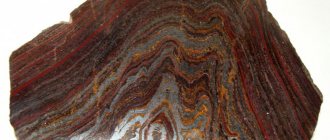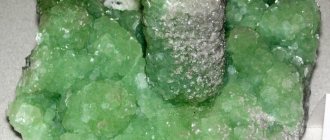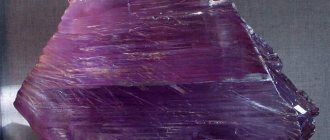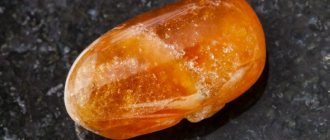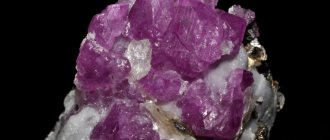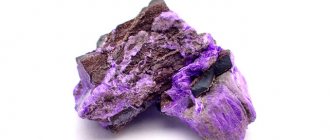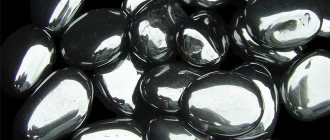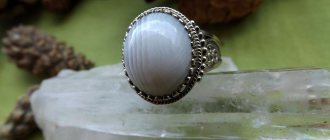/ List of stones / Magical and healing properties of Bronzite stone
0
3979
Article rating
Bronzite stone owes its name to its bright bronze color and characteristic golden luster, which has made it a popular stone. In Russia, this gem is less common than in Europe, where it is often used to make jewelry, accessories, and jewelry with Bronzite is a popular gift in the business sphere.
Stone Bronzite
When processed, the gemstone is given a predominantly rounded shape, which fully expresses and emphasizes its beauty.
Bronzite deposits
Bronzite is included in the composition of basalt, peridotite and similar rocks of igneous origin.
It was also discovered that it is an integral part of the substance of meteorites falling on our planet. — Advertising —
Large deposits of bronzite are located in the Urals (Russia). In addition, mineral deposits are located in countries such as the USA, Austria, Sweden, Portugal and Australia.
In general, the stone is quite widespread, and the first samples were found in Australia. Sometimes small bronzite deposits are found in India, Brazil and Germany.
Chemical composition
Bronsites include orthorhombic pyroxenes with FeO from 5 to 13%, according to Strunz (1970), and from 6.50 to 16.0%, according to Dear et al. (1965). In natural bronzites, the amount of FeO may exceed accepted limits, but nevertheless, based on other properties, the mineral is diagnosed as bronzite, and, conversely, the FeO content may correspond to bronzite, and the mineral is determined as enstatite or hypersthene. The MgO content ranges from 30.5% to 22% and is inversely related to FeO. The SiO content, 51.00–55.00%, is mainly correlated with Al2O3. Al2O3 content from 0.42 to 12.0 (usually less than 1.5%).
They are characterized by an Al2O3 content of 2.0–4.0% from deep inclusions of ultrabasic rocks in kimberlites, less often in effusive rocks; higher levels (4–6% to 12%) are observed in bronzites of high-alumina metamorphic rocks and alkaline basalts. A mineral containing more than 2% Al2O3 is called aluminum bronzite. Other components: Fe2O3 - up to 2.0%, rarely higher; CaO - from 0.5 to 3.5% (usually 1.0-1.5%, at higher contents the presence of inclusions of calcium monoclinic pyroxenes is assumed); MnO - up to 0.4%, TiO2 - up to 0.45%, rarely up to 1.3%; Cr2O3 - up to 0.3%, sometimes up to 0.6%. Increased concentrations of TiO2 and Cr2O3 are characteristic of bronzites from lunar rocks. Na and K are not always established in bronzites; the Na2O content does not exceed 0.4, and K2O - 0.04%. Some minerals contain up to 0.01% P2O5. The usual H2O+ content is 0.3-0.5%, sometimes up to 1.4%; the H2O_ content fluctuates within the same limits. Occasionally, fluorine is observed in bronzites (about 0.08%), for example, in bronzite from the gabbro-norite pegmatite Nittis (Kola Peninsula). In bronzite from bronzite veins in the anorthosite massif of the Dzhugdzhur Range. (Okhotsk coast, Russia) 0.07% V2O3 was established. Spectral analysis in bronzite from ultrabasic rocks of the Middle Bug region determined (in%): Cr 0.055-0.15, Co 0.005-0.007, Ni 0.034-0.038. Bronzite from pyroxenite and gabbro of Monchetundra (Kola Peninsula) contains 0.003% ZrO2. Bronzite from rocks of gold deposits in Northern Kazakhstan contains Cu and Au. Rocks from the ultramafic zone of the Stillwater complex (Montana, USA) contain an excess amount of Ar40, which is associated with its accumulation during primary crystallization.
Crystallographic characteristics
system .
Class. Rhombo-bipyramidal. Axle ratio. 2.062: 1: 0.588.
Form of bronzite in nature
The crystal structure, polymorphism pattern, crystal shape and twinning are similar to those of enstatite.
Aggregates. Elongated and short prismatic crystals, grains, granular masses, microlites.
In bronzite individuals, plates of monoclinic and orthorhombic pyroxenes are often observed, parallel to (100) bronzite, which are considered to be products of solid solution decomposition. As shown by X-ray, electron microscopy and microprobe studies, bronzite with the composition Mg0.81Fe0.16 Ca0.03SiO3 from the Stillwater complex (Montana) contains plates 0.5 μm thick, composed of augite with 24% CaO; they account for up to 1.4% of the grain volume. Clinopyroxene plates (with 19.7% CaO) 3–10 µm thick are set in bronzite (FeO 10.6%, CaO 1.2%) from olivine pyroxenite of the Kibi Plateau in Southwestern Japan. In lunar samples and meteorites, decay plates are observed that correspond in properties to clinobronzite. In a mineral with Fs 20% from the anorthosite massif of the Dzhugdzhur Range. Hypersthene plates with Fs 43% were identified as a product of solid solution decomposition. In stone from heavily deformed and partially metamorphosed gabbro of Central Australia, diopside plates located along (100) bronzite and kink bands composed of clinoenstatite, which arose under the action of deformation stresses, were noted. In lunar KREEP basalts (Apollo 14), a regular growth of twinned magnesian pigeonite was observed on bronzite along the (100) plane. Myrmekite intergrowths of bronzite with ilmenite are found in rocks of the lower zone of the Skergard intrusion (East Greenland) and in a sample of lunar breccia (Apollo 16). Symplectite intergrowths of bronzite and magnetite surrounding or completely replacing olivine grains occur in the mafic rocks of the layered Wateranga intrusion in Australia. In many crystals from the gabbro-norite pegmatite of Mount Nittis in Monchetundra (Kola Peninsula), thin hair-like cracks are filled with mineral/diopside sulfides. Bronzite in pyrope-bronzite-sillimanite crystalline schists of the Stanovoy Range forms thin intergrowths with sillimanite. In the rock from the lunar microbreccia (Apollo 14), inclusions of rutile crystals were observed, oriented parallel to the c-axis.
Physico-chemical characteristics of bronzite
The shape of bronzite crystals is usually represented by short-columnar prisms.
Irregularly shaped specimens and dense massive aggregates are also found. The color of the stone is due to the presence of manganese and iron impurities in its composition, which is expressed in brown, yellow-brown, greenish-brown shades. Bronzite is characterized by heterogeneous coloring, with the presence of various shades of the same color in one sample. In addition, the gem exhibits a bright bronze metallic sheen.
— Advertising —
Bronzite is opaque, sometimes small internal cavities are found in its specimens, due to which the “cat's eye” effect appears.
Hardness on the Mohs scale is 5-6. Specific gravity from 3.3 to 3.35 g/cm3. The crystals have average cleavage and have an orthorhombic system.
Stone cost
The price of processed stone is low. The cost of a large bead ranges from 100 to 200 rubles. A finished bronzite bracelet costs 800-1000 rubles. The price of other jewelry depends on the setting and size of the stone. A medium-sized silver ring with bronzite will cost 1000-1700 rubles. The price of a necklace can reach up to 4,000 rubles.
The price of bronzite souvenirs also depends on the specific gravity. A figurine 10 cm high will cost around 3000-5000 rubles. The cost of interior items or decor will be significant due to the large amount of stone itself.
The price per gram of industrial bronzite is much lower. For example, a countertop made of natural mineral will cost 12,000–23,000 rubles.
If you love bronzite and have information about it, share your knowledge in the comments.
Types of bronzite
Industrial bronzite is a granular brown mass.
For jewelry purposes, specimens with a scaly structure, painted in golden, brown, green-brown or yellow, and other shades that look like bronze are used. Bronzite flakes are unique in their shape, and often resemble fallen autumn leaves. An interesting subspecies of jewelry bronzites are stones with rich green tints in color. These colors are characteristic of calcium (lime) bronzite. In the USA it is known as jasper bronzite, and in many other countries as lime bronzite (pictured).
— Advertising —
Another variety of bronzite called festin is also popular among collectors. It contains inclusions of serpentine and has beautiful external qualities. This mineral exquisitely combines a rich, heterogeneous green color with the faint shine of the stone’s scales.
Varieties
In addition to the basic elements, bronzite contains “minor” ones, which, however, affect how the stone looks. Depending on the impurities, the mineral is divided into:
- calcium or limestone. Also known as jasper or lime;
- festin - interspersed with serpentine;
- morandite;
- aluminum bronzite.
This is interesting! In northern Kazakhstan, bronzite with inclusions of gold and copper is found, and in the American state of Montana - with admixtures of silver.
Magic properties of bronzite
A well-known quality of bronzite is its beautiful metallic luster.
Thanks to this property, it is believed that the stone is able to attract gold, money and wealth. Bronzite helps achieve financial stability, and for this there will be no need to work hard and hard. Money, thanks to the magical qualities of bronzite, just “flows like a river” to its owner in all possible ways. This effect of the mineral is associated with its energy potential, which is in tune with the money chakra of Manipur. Bronzite helps to cleanse it and direct the movement of energy in the right direction. As a result, a person opens up new sources of income, and unplanned expenses are significantly reduced, money is delayed and accumulated, as if beginning to “love” the person.
In addition to attracting material wealth and prosperity into people’s lives, bronzite can also help doctors. It makes their work easier and simpler, helps them make accurate diagnoses and determine treatment. Therefore, many doctors use bronzite talismans in their work.
Storage and care
A strong nugget is practically not afraid of mechanical friction and remains perfect for a long time, but it must be worn with care, in fact, like any gem. Soft material is stored in separate boxes, wrapped in cloth.
He is not afraid of temperature changes or exposure to ultraviolet radiation. When cleaning, wipe with a damp cloth, then polish with wool. To charge it with magical power, the stone is placed next to the rock crystal for a while.
Important! It is not advisable to use abrasive substances or chemicals when cleaning.
Healing properties of bronzite
In lithotherapy, bronzite is used to treat skin diseases.
With its help, diseases such as psoriasis and eczema, dermatitis and acne are easier. The mineral also reduces the appearance of age-related changes in the skin and normalizes the functioning of the sebaceous glands. In addition, bronzite has the ability to normalize the functioning of the endocrine system. For this purpose, it is recommended to wear necklaces or pendants made of the mineral. Bronzite normalizes the condition of the thyroid gland and helps in the treatment of its diseases.
Healing properties and what does it help with?
Dermatologists who study this stone claim a healing effect on the skin. When wearing a mineral on the body, it is possible to forget about dermatological problems, simplify the course of skin pathologies and quickly cure eczema. This is important for people who suffer from flaking and dry skin.
Bronzite is needed during the transitional age of children. It will help restore the functionality of the sebaceous glands, thereby freeing the skin of children from inflammation, acne and ulcers. For those who want to heal the endocrine system, you should purchase a necklace with a piece of bronzite or a ring. Dermatologists believe that wearing jewelry can help reduce the volume of the goiter and prevent secondary suppuration.
The gem relieves pain in the temples, high blood pressure, and prevents the development of viral diseases.
Branches of application of bronzite
Gem-quality bronzes are widely used in jewelry.
When cut into cabochons, they are used as inserts in various jewelry. The stone looks great in light metal frames, which highlight its bronze shimmer. Bracelets, beads, pendants, rings, and earrings are made from bronzites. All shades of bronzite appear best when processed in a rounded form, and its medium degree of hardness makes cutting and polishing a fairly simple process. Buyers like the unusual appearance and relatively low cost of the stone, and jewelers value broznit for its versatility and ease of processing. In addition to jewelry, bronzites are used to make various crafts and souvenirs. A vase, box or candlestick made of bronzite also looks great.
Moreover, even countertops, statues and floor tiles are made from bronzite, as it has a very low wear rate.
Finally, bronzite amulets and talismans are popular, used by doctors and everyone who wants to get rich.
How to distinguish a real stone from a fake
Despite the relatively low price, fake gems are often found on the market. They are made of glass or polymer plastic. To reliably identify a fake, you need to contact a mineralogist. However, knowing some of the properties of the stone, any buyer can identify a cheap fake.
The natural mineral has the following distinctive qualities:
- Low heat capacity. The stone feels cold to the touch even in warm weather. It warms up slowly under the influence of sunlight and body temperature.
- High density and heaviness. The naturally occurring mineral is much heavier than its plastic and glass counterparts.
- Unique drawing. Each real stone is different from the other. Even among samples obtained from the same deposit, there are different shades and inclusions. If all the minerals in a batch are identical, they are most likely counterfeit.
It is best to assess the quality of a stone using a magnifying glass. This way you can examine the pattern of the mineral in more detail. Also, the inspection must be performed in both natural and artificial light.
Bronzite colors
The shades of natural bronzite are associated with the presence of manganese and iron impurities in the mineral.
The color range of the mineral is represented by greenish-brown, brown, nut-brown, bronze and yellow-brown shades. In addition, the stone is characterized by a variety of inclusions and colors in one sample, and also shines spectacularly with a metallic luster.
Compatibility with other stones in jewelry
Bronzite should be combined with other minerals not only according to color and density. It is worth paying attention to belonging to the zodiac spectrum of signs.
As you know, each stone will become the best companion for one or another stellar representative. Therefore, bronzite will be ideally combined with:
- fire stones (amber, diamond, hematite, coral, grossular, spinel, heliolite, zircon);
- air minerals (jasper, ruby, garnet, alexandrite, jade, quartz, sapphire).
How to care for bronzite
Bronzite is simple and undemanding to care for.
Stone products are regularly polished with pieces of felt or suede fabric. Heavily contaminated bronzite is washed with a weak soap solution. But it is important to remember that natural stone deteriorates when exposed to chemicals such as vinegar, chlorine, and various solvents. Therefore, the latter are not used for its purification. Bronze amulets are charged with positive energy from natural crystal.
History and origin
The mineral itself has been known to researchers of igneous rocks for a long time. But it owes its name to the German mineralogist Dietrich Gustav Ludwig Karsten. Drawing attention to the striking similarity of the stone with slightly darkened bronze, Carsten called it bronzite, and under this name he included it in his own catalog of minerals in 1807.
Mineral - Bronzite
Bronzite and zodiac sign
Bronzite is a talisman for all Leos.
For representatives of this zodiac sign, the mineral is the best protector; it develops the good character traits of its owner, stimulates self-development, and reliably protects against troubles and bad events. The stone is not recommended for Taurus and Capricorn. It can complicate life for these zodiac signs, contribute to fatigue and poor performance.
All other zodiac signs can wear products made from bronzites without fear of negative consequences, but also without expecting a particularly strong positive effect.
Interesting facts about bronzite:
- High-quality gem-quality bright golden-yellow bronzites were discovered on the island of Sri Lanka. Bronzites native to Tanzania are known for their transparency, which is not typical for other deposits. In the Urals, so-called “serpentine bronzites” are mined, green in color with beautiful patterns.
- Bronzite is a common mineral. Its deposits are located in America, Australia, Africa, and Europe. Moreover, the mineral was discovered even in Antarctica and on the Moon. Specimens of lunar bronzite were brought to Earth from the Soviet Luna 20 probes and from the American Apollo 14 and Apollo 16 expeditions. They are characterized by a high content of chromium and titanium.
- When processed, bronzite can be cleared of greenish inclusions and made it very similar to a gold alloy.
Mineral Change
The most widespread manifestation was its replacement by serpentine with the formation of homoaxial pseudomorphs - bastite (or schillerspar). Bastitization develops according to the following scheme: protobastite (bronzite with a different optical orientation) diaclazite bastite. Similar products that retain a metallic luster are called festin (Fichtel Mountains, Germany), according to Breithaupt (1823). Bronzite in inclusions from kimberlites of Yakutia is replaced by serpentine and calcite until a honeycomb (box) structure and bastite pseudomorphs are formed. In the gabbro-norites of the Pan Heights on the Kola Peninsula it is amphibolized, especially at the contact with plagioclase; in the gabbro-norite pegmatite of Monchetundra (Kola Peninsula) it is partially replaced by actinolite, talc and chlorite.
